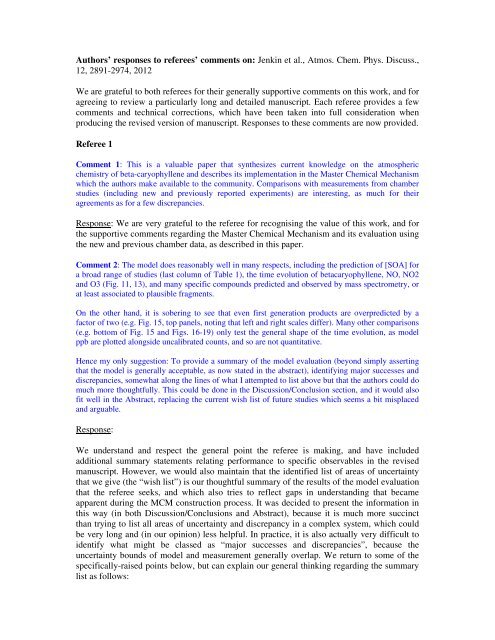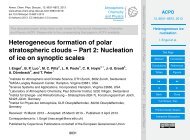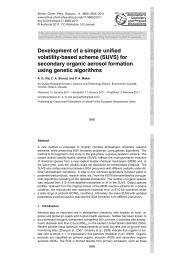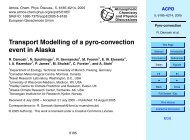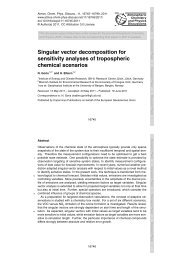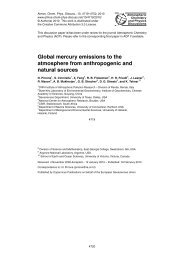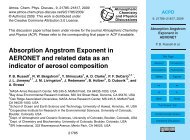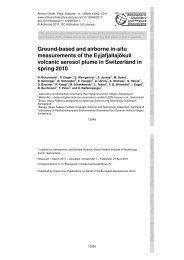Authors' responses to referees' comments on: Jenkin et al., Atmos ...
Authors' responses to referees' comments on: Jenkin et al., Atmos ...
Authors' responses to referees' comments on: Jenkin et al., Atmos ...
You also want an ePaper? Increase the reach of your titles
YUMPU automatically turns print PDFs into web optimized ePapers that Google loves.
Authors’ <str<strong>on</strong>g>resp<strong>on</strong>ses</str<strong>on</strong>g> <str<strong>on</strong>g>to</str<strong>on</strong>g> referees’ <str<strong>on</strong>g>comments</str<strong>on</strong>g> <strong>on</strong>: <strong>Jenkin</strong> <strong>et</strong> <strong>al</strong>., <strong>Atmos</strong>. Chem. Phys. Discuss.,<br />
12, 2891-2974, 2012<br />
We are grateful <str<strong>on</strong>g>to</str<strong>on</strong>g> both referees for their gener<strong>al</strong>ly supportive <str<strong>on</strong>g>comments</str<strong>on</strong>g> <strong>on</strong> this work, and for<br />
agreeing <str<strong>on</strong>g>to</str<strong>on</strong>g> review a particularly l<strong>on</strong>g and d<strong>et</strong>ailed manuscript. Each referee provides a few<br />
<str<strong>on</strong>g>comments</str<strong>on</strong>g> and technic<strong>al</strong> correcti<strong>on</strong>s, which have been taken in<str<strong>on</strong>g>to</str<strong>on</strong>g> full c<strong>on</strong>siderati<strong>on</strong> when<br />
producing the revised versi<strong>on</strong> of manuscript. Resp<strong>on</strong>ses <str<strong>on</strong>g>to</str<strong>on</strong>g> these <str<strong>on</strong>g>comments</str<strong>on</strong>g> are now provided.<br />
Referee 1<br />
Comment 1: This is a v<strong>al</strong>uable paper that synthesizes current knowledge <strong>on</strong> the atmospheric<br />
chemistry of b<strong>et</strong>a-caryophyllene and describes its implementati<strong>on</strong> in the Master Chemic<strong>al</strong> Mechanism<br />
which the authors make available <str<strong>on</strong>g>to</str<strong>on</strong>g> the community. Comparis<strong>on</strong>s with measurements from chamber<br />
studies (including new and previously reported experiments) are interesting, as much for their<br />
agreements as for a few discrepancies.<br />
Resp<strong>on</strong>se: We are very grateful <str<strong>on</strong>g>to</str<strong>on</strong>g> the referee for recognising the v<strong>al</strong>ue of this work, and for<br />
the supportive <str<strong>on</strong>g>comments</str<strong>on</strong>g> regarding the Master Chemic<strong>al</strong> Mechanism and its ev<strong>al</strong>uati<strong>on</strong> using<br />
the new and previous chamber data, as described in this paper.<br />
Comment 2: The model does reas<strong>on</strong>ably well in many respects, including the predicti<strong>on</strong> of [SOA] for<br />
a broad range of studies (last column of Table 1), the time evoluti<strong>on</strong> of b<strong>et</strong>acaryophyllene, NO, NO2<br />
and O3 (Fig. 11, 13), and many specific compounds predicted and observed by mass spectrom<strong>et</strong>ry, or<br />
at least associated <str<strong>on</strong>g>to</str<strong>on</strong>g> plausible fragments.<br />
On the other hand, it is sobering <str<strong>on</strong>g>to</str<strong>on</strong>g> see that even first generati<strong>on</strong> products are overpredicted by a<br />
fac<str<strong>on</strong>g>to</str<strong>on</strong>g>r of two (e.g. Fig. 15, <str<strong>on</strong>g>to</str<strong>on</strong>g>p panels, noting that left and right sc<strong>al</strong>es differ). Many other comparis<strong>on</strong>s<br />
(e.g. bot<str<strong>on</strong>g>to</str<strong>on</strong>g>m of Fig. 15 and Figs. 16-19) <strong>on</strong>ly test the gener<strong>al</strong> shape of the time evoluti<strong>on</strong>, as model<br />
ppb are plotted <strong>al</strong><strong>on</strong>gside unc<strong>al</strong>ibrated counts, and so are not quantitative.<br />
Hence my <strong>on</strong>ly suggesti<strong>on</strong>: To provide a summary of the model ev<strong>al</strong>uati<strong>on</strong> (bey<strong>on</strong>d simply asserting<br />
that the model is gener<strong>al</strong>ly acceptable, as now stated in the abstract), identifying major successes and<br />
discrepancies, somewhat <strong>al</strong><strong>on</strong>g the lines of what I attempted <str<strong>on</strong>g>to</str<strong>on</strong>g> list above but that the authors could do<br />
much more thoughtfully. This could be d<strong>on</strong>e in the Discussi<strong>on</strong>/C<strong>on</strong>clusi<strong>on</strong> secti<strong>on</strong>, and it would <strong>al</strong>so<br />
fit well in the Abstract, replacing the current wish list of future studies which seems a bit misplaced<br />
and arguable.<br />
Resp<strong>on</strong>se:<br />
We understand and respect the gener<strong>al</strong> point the referee is making, and have included<br />
additi<strong>on</strong><strong>al</strong> summary statements relating performance <str<strong>on</strong>g>to</str<strong>on</strong>g> specific observables in the revised<br />
manuscript. However, we would <strong>al</strong>so maintain that the identified list of areas of uncertainty<br />
that we give (the “wish list”) is our thoughtful summary of the results of the model ev<strong>al</strong>uati<strong>on</strong><br />
that the referee seeks, and which <strong>al</strong>so tries <str<strong>on</strong>g>to</str<strong>on</strong>g> reflect gaps in understanding that became<br />
apparent during the MCM c<strong>on</strong>structi<strong>on</strong> process. It was decided <str<strong>on</strong>g>to</str<strong>on</strong>g> present the informati<strong>on</strong> in<br />
this way (in both Discussi<strong>on</strong>/C<strong>on</strong>clusi<strong>on</strong>s and Abstract), because it is much more succinct<br />
than trying <str<strong>on</strong>g>to</str<strong>on</strong>g> list <strong>al</strong>l areas of uncertainty and discrepancy in a complex system, which could<br />
be very l<strong>on</strong>g and (in our opini<strong>on</strong>) less helpful. In practice, it is <strong>al</strong>so actu<strong>al</strong>ly very difficult <str<strong>on</strong>g>to</str<strong>on</strong>g><br />
identify what might be classed as “major successes and discrepancies”, because the<br />
uncertainty bounds of model and measurement gener<strong>al</strong>ly overlap. We r<strong>et</strong>urn <str<strong>on</strong>g>to</str<strong>on</strong>g> some of the<br />
specific<strong>al</strong>ly-raised points below, but can explain our gener<strong>al</strong> thinking regarding the summary<br />
list as follows:
a) Species possessing the sec<strong>on</strong>dary oz<strong>on</strong>ide functi<strong>on</strong><strong>al</strong>ity (which are comparatively volatile)<br />
are predicted <str<strong>on</strong>g>to</str<strong>on</strong>g> make major (but uncertain) c<strong>on</strong>tributi<strong>on</strong>s <str<strong>on</strong>g>to</str<strong>on</strong>g> the simulated first- and sec<strong>on</strong>dgenerati<strong>on</strong><br />
product distributi<strong>on</strong>. This introduced uncertainty in<str<strong>on</strong>g>to</str<strong>on</strong>g> sever<strong>al</strong> aspects of model<br />
performance, including the model-measurement comparis<strong>on</strong>s of m/z 253 in the gas phase (i.e.<br />
the <str<strong>on</strong>g>to</str<strong>on</strong>g>p panel of Fig. 15 commented <strong>on</strong> by the referee) and of the SOA profiles. These were<br />
therefore sensitive <str<strong>on</strong>g>to</str<strong>on</strong>g> the primary yield assigned <str<strong>on</strong>g>to</str<strong>on</strong>g> the sec<strong>on</strong>dary oz<strong>on</strong>ide, and the extent <str<strong>on</strong>g>to</str<strong>on</strong>g><br />
which this functi<strong>on</strong><strong>al</strong>ity is r<strong>et</strong>ained up<strong>on</strong> further oxidati<strong>on</strong>. This is therefore identified as<br />
point (i) in Abstract (first bull<strong>et</strong> in Dicsussi<strong>on</strong>/C<strong>on</strong>clusi<strong>on</strong>s), <str<strong>on</strong>g>to</str<strong>on</strong>g> reflect the level of<br />
success/discrepancy in simulating the observables identified above.<br />
b) The formati<strong>on</strong> mechanism for E-caryophyllinic acid (C137CO2H) is currently not known,<br />
and the provisi<strong>on</strong><strong>al</strong> representati<strong>on</strong> used in the MCM is apparently unable <str<strong>on</strong>g>to</str<strong>on</strong>g> explain its<br />
observati<strong>on</strong> in some reported studies. On the other hand, the formati<strong>on</strong> of its isomer, bnocaryophyll<strong>on</strong>ic<br />
acid (C131CO2H), seems <strong>al</strong>most inevitable as an important sec<strong>on</strong>dgenerati<strong>on</strong><br />
product of the further oxidati<strong>on</strong> of E-caryophyll<strong>on</strong>ic acid (C141CO2H), <strong>al</strong>though<br />
this has not been reported in some studies where its major formati<strong>on</strong> is predicted by the<br />
MCM chemistry. These issues are therefore identified as points (ii) and (iii), <str<strong>on</strong>g>to</str<strong>on</strong>g> reflect the<br />
model-measurement successes/discrepancies in the various systems c<strong>on</strong>sidered. (The<br />
referee’s comment (3f) below would <strong>al</strong>so appear <str<strong>on</strong>g>to</str<strong>on</strong>g> support inclusi<strong>on</strong> of point (iii) in this<br />
way).<br />
c) We found that <str<strong>on</strong>g>to</str<strong>on</strong>g> recreate the observed E-caryophyllene, oz<strong>on</strong>e and NOx profiles in the<br />
chamber pho<str<strong>on</strong>g>to</str<strong>on</strong>g>-oxidati<strong>on</strong> studies, it was necessary <str<strong>on</strong>g>to</str<strong>on</strong>g> change either or both of the primary OH<br />
yield from E -caryophyllene oz<strong>on</strong>olysis and the hydroxy nitrate yield from the OH-initiated<br />
chemistry within reported bounds – the simulati<strong>on</strong>s being very sensitive <str<strong>on</strong>g>to</str<strong>on</strong>g> these param<strong>et</strong>ers.<br />
The need for improved quantificati<strong>on</strong> of these param<strong>et</strong>ers is therefore identified as points (iv)<br />
and (v).<br />
d) The simulated compositi<strong>on</strong> of SOA in the absence of NOx invariably had major<br />
c<strong>on</strong>tributi<strong>on</strong>s from multifuncti<strong>on</strong><strong>al</strong> species possessing hydroperoxide groups, <strong>al</strong>though no<br />
such species have currently been reported in observati<strong>on</strong><strong>al</strong> studies. This was therefore<br />
specific<strong>al</strong>ly identified in point (vi), as part of a more gener<strong>al</strong> statement about product<br />
identificati<strong>on</strong> and quantificati<strong>on</strong> in both SOA and gas phases.<br />
These points are explained in some d<strong>et</strong>ail in the Discussi<strong>on</strong>/C<strong>on</strong>clusi<strong>on</strong>s, but are necessarily<br />
presented more briefly in the Abstract. We are reluctant <str<strong>on</strong>g>to</str<strong>on</strong>g> remove the list from the Abstract;<br />
however, as indicated above we have expanded the gener<strong>al</strong> statement about acceptable model<br />
performance in both Discussi<strong>on</strong>/C<strong>on</strong>clusi<strong>on</strong>s and Abstract, by relating this <str<strong>on</strong>g>to</str<strong>on</strong>g> the specific<br />
observables, and by linking it <str<strong>on</strong>g>to</str<strong>on</strong>g> the summary list more clearly.<br />
C<strong>on</strong>cerning the referee’s specific comment about the “ sobering” fac<str<strong>on</strong>g>to</str<strong>on</strong>g>r of two model<br />
overestimati<strong>on</strong> of the first-generati<strong>on</strong> gas phase products in the <str<strong>on</strong>g>to</str<strong>on</strong>g>p panel of Fig 15, we<br />
recognise that, at first sight, this might appear <str<strong>on</strong>g>to</str<strong>on</strong>g> be relatively poor agreement that may<br />
simply be accounted for by a yield error in the mechanism. However, we were actu<strong>al</strong>ly<br />
delighted with this level of model-measurement agreement, which we think is fully<br />
acceptable given the uncertainties in mechanistic understanding, in vapour pressure<br />
estimati<strong>on</strong> and in the c<strong>al</strong>ibrati<strong>on</strong> of the CIR-TOF-MS sign<strong>al</strong>s (indeed, this exemplifies why it<br />
is som<strong>et</strong>imes quite difficult <str<strong>on</strong>g>to</str<strong>on</strong>g> class such a result as either a “ major success” or a “ major<br />
discrepancy” in mechanistic ev<strong>al</strong>uati<strong>on</strong> studies, and why it can be more instructive <str<strong>on</strong>g>to</str<strong>on</strong>g>
highlight uncertainties and where future work is required). The discussi<strong>on</strong> in secti<strong>on</strong> 6.3.1<br />
indicates that the CIR-TOF-MS sign<strong>al</strong>s are uncertain <str<strong>on</strong>g>to</str<strong>on</strong>g> approximately +/- 40% and possibly<br />
miss additi<strong>on</strong><strong>al</strong> c<strong>on</strong>tributi<strong>on</strong>s from sm<strong>al</strong>l unspecific fragments. It <strong>al</strong>so <str<strong>on</strong>g>comments</str<strong>on</strong>g> <strong>on</strong> the<br />
sensitivity of the gas phase simulati<strong>on</strong>s <str<strong>on</strong>g>to</str<strong>on</strong>g> the vapour pressure estimates, and (for m/z 253)<br />
the extent <str<strong>on</strong>g>to</str<strong>on</strong>g> which the more volatile sec<strong>on</strong>dary oz<strong>on</strong>ide c<strong>on</strong>tributes <str<strong>on</strong>g>to</str<strong>on</strong>g> the sign<strong>al</strong>. In view of<br />
the referee’ s comment, we have added a statement <str<strong>on</strong>g>to</str<strong>on</strong>g> the capti<strong>on</strong> of Fig. 15 <str<strong>on</strong>g>to</str<strong>on</strong>g> refer the reader<br />
more directly <str<strong>on</strong>g>to</str<strong>on</strong>g> the discussi<strong>on</strong> in secti<strong>on</strong> 6.3.1, thereby <strong>al</strong>lowing the fac<str<strong>on</strong>g>to</str<strong>on</strong>g>r of two<br />
discrepancy in the Figure <str<strong>on</strong>g>to</str<strong>on</strong>g> be put in<str<strong>on</strong>g>to</str<strong>on</strong>g> c<strong>on</strong>text.<br />
The remaining comparis<strong>on</strong>s (for both the new CIR-TOF-MS data and the previously reported<br />
PTR-MS data for Lee <strong>et</strong> <strong>al</strong>.) are semi-quantitative, with the relative magnitudes of the<br />
c<strong>al</strong>ibrated vs. unc<strong>al</strong>ibrated sign<strong>al</strong>s giving an estimati<strong>on</strong> of c<strong>on</strong>centrati<strong>on</strong> (given knowledge of<br />
fragmentati<strong>on</strong> behaviour), with PTR sensitivities being of similar orders of magnitude<br />
b<strong>et</strong>ween structur<strong>al</strong>ly similar species. As recognised by the referee, the primary aim of these<br />
comparis<strong>on</strong>s is, however, <str<strong>on</strong>g>to</str<strong>on</strong>g> compare the shapes of the various profiles, which <strong>al</strong>lows<br />
v<strong>al</strong>uable c<strong>on</strong>clusi<strong>on</strong>s <str<strong>on</strong>g>to</str<strong>on</strong>g> be drawn c<strong>on</strong>cerning product identities, the oxidati<strong>on</strong> generati<strong>on</strong> in<br />
which they are formed and their lif<strong>et</strong>imes – and of course wh<strong>et</strong>her the mechanism/model is<br />
able <str<strong>on</strong>g>to</str<strong>on</strong>g> recreate the observati<strong>on</strong>. Because of a lack of authentic standards, it was not possible<br />
<str<strong>on</strong>g>to</str<strong>on</strong>g> c<strong>al</strong>ibrate <strong>al</strong>l the many d<strong>et</strong>ected sign<strong>al</strong>s, and focus was therefore placed <strong>on</strong> c<strong>al</strong>culating the<br />
sensitivities for the species c<strong>on</strong>tributing <str<strong>on</strong>g>to</str<strong>on</strong>g> the major product families of m/z 253 and 237.<br />
Comment 3: Technic<strong>al</strong> suggesti<strong>on</strong>s:<br />
a) “ Fig. 5 capti<strong>on</strong> (and other figures): "figures" -> "v<strong>al</strong>ues" or "numbers".”<br />
Resp<strong>on</strong>se: We agree with the referee and have amended these terms accordingly in the<br />
revised manuscript.<br />
b) “ p.2902 and later: exocyclic need not be in quotes.”<br />
Resp<strong>on</strong>se: When referring <str<strong>on</strong>g>to</str<strong>on</strong>g> the residu<strong>al</strong> double b<strong>on</strong>d in a given product in which the Ecaryophyllene<br />
endocyclic double b<strong>on</strong>d has previously been oxidised, we place the term<br />
“ exocyclic” in quotes because the cycle <str<strong>on</strong>g>to</str<strong>on</strong>g> which the b<strong>on</strong>d was origin<strong>al</strong>ly exocyclic in Ecaryophyllene<br />
no l<strong>on</strong>ger exists in many of the products. Thus, the b<strong>on</strong>d is strictly not<br />
exocyclic, and the term is being used as a c<strong>on</strong>venient label. The purpose of the quotes will be<br />
explained at first use in the revised manuscript. (Note that the same does not apply <str<strong>on</strong>g>to</str<strong>on</strong>g> the<br />
endocyclic b<strong>on</strong>ds in products in which the E-caryophyllene exocyclic double b<strong>on</strong>d has<br />
previously been oxidised, and the term endocyclic is therefore not placed in quotes).<br />
c) p.2906/l.3: presumably mean CH3C(O)OO = ac<strong>et</strong>yl peroxy radic<strong>al</strong>, not CH3(O)O2<br />
eq. 2 <strong>al</strong>ignment<br />
Resp<strong>on</strong>se: The referee is correct, and we have amended this in the revised manuscript.<br />
d) p.2911/15-20: The discussi<strong>on</strong> of the source of NO is unclear, Do you mean "minimizing" rather<br />
than "optimizing"? Is "subtle" influence sm<strong>al</strong>l but important, or sm<strong>al</strong>l and not important? Also, it is<br />
well known that NO2 will outgas from tefl<strong>on</strong> surfaces. Are you sure the source was NO rather than<br />
NO2?<br />
Resp<strong>on</strong>se: The simulati<strong>on</strong>s definitely required the source <str<strong>on</strong>g>to</str<strong>on</strong>g> be in the form of NO, which we<br />
agree is unusu<strong>al</strong> and needed <str<strong>on</strong>g>to</str<strong>on</strong>g> be reported, even though we cannot explain its origin at this
stage. This is being investigated further as part of <strong>on</strong>going chamber ev<strong>al</strong>uati<strong>on</strong>, and chamber<br />
processes will be reported <strong>on</strong> more fully elsewhere. Inclusi<strong>on</strong> of the source improved the<br />
qu<strong>al</strong>ity of the comparis<strong>on</strong> of the modelled and measured NO profiles, particularly in the early<br />
stages of the experiment. Its effect <strong>on</strong> the comparis<strong>on</strong>s for E-caryophyllene, NO2 and oz<strong>on</strong>e<br />
was sm<strong>al</strong>l and unimportant in improving model agreement. We have clarified this in the<br />
revised manuscript. It is <strong>al</strong>so noted that the profiles for <strong>al</strong>l these species were most sensitive<br />
<str<strong>on</strong>g>to</str<strong>on</strong>g> the gas phase chemistry initiated by NO2 pho<str<strong>on</strong>g>to</str<strong>on</strong>g>lysis.<br />
e) Table 1: [SOA] needs units.<br />
Resp<strong>on</strong>se: This has been amended in the revised manuscript.<br />
f) p. 2916/17-22: It’ s unfortunate that the main SOA product, C131CO2H, was not seen by Li <strong>et</strong> <strong>al</strong>.<br />
But the MCM predicti<strong>on</strong> should help motivate its future d<strong>et</strong>ecti<strong>on</strong>.<br />
Resp<strong>on</strong>se: We agree, and hope that our work will help inform and motivate future<br />
investigati<strong>on</strong>s.<br />
Referee 2<br />
Comment 1: The authors present in this manuscript a “ d<strong>et</strong>ailed” degradati<strong>on</strong> mechanism for <strong>on</strong>e of<br />
the most important sesquiterpene emitted <str<strong>on</strong>g>to</str<strong>on</strong>g> ambient atmosphere: b<strong>et</strong>a-caryophyllene. The authors use<br />
the MCM mechanism that is build using solid knowledge of kin<strong>et</strong>ic degradati<strong>on</strong> of b-caryophyllene as<br />
well as its degradati<strong>on</strong> products. The performance of the MCM mechanism was ev<strong>al</strong>uated using a<br />
series of experiment<strong>al</strong> data obtained either from the literature or originated directly from smog<br />
chamber experiments c<strong>on</strong>ducted by the authors. The experiment<strong>al</strong> data comprises a wide vari<strong>et</strong>y of<br />
c<strong>on</strong>diti<strong>on</strong>s: e.g. oz<strong>on</strong>olysis, pho<str<strong>on</strong>g>to</str<strong>on</strong>g>oxidati<strong>on</strong> in the presence of NOx <strong>et</strong>c: : : Although the model is very<br />
complex (280 multi-functi<strong>on</strong><strong>al</strong> compounds) and is based <strong>on</strong> a vari<strong>et</strong>y of assumpti<strong>on</strong>s as well as its<br />
combinati<strong>on</strong> with chamber auxiliary mechanism developed using another smog chamber (w<strong>al</strong>l<br />
chemistry), the model seams <str<strong>on</strong>g>to</str<strong>on</strong>g> produce a reas<strong>on</strong>ably well picture of the SOA as well as products<br />
distributi<strong>on</strong> either in the gas or in the particle phases.<br />
Resp<strong>on</strong>se: We are very grateful <str<strong>on</strong>g>to</str<strong>on</strong>g> the referee for recognising the v<strong>al</strong>ue of this work.<br />
Comment 2: As menti<strong>on</strong>ed by the authors, the mechanism is based <strong>on</strong> a d<strong>et</strong>ailed degradati<strong>on</strong> of bcaryophyllene<br />
that is expensive and time c<strong>on</strong>suming <str<strong>on</strong>g>to</str<strong>on</strong>g> be implemented directly in applicati<strong>on</strong>s<br />
requiring great computati<strong>on</strong><strong>al</strong> efficiency. It will be suitable if the authors provide <str<strong>on</strong>g>to</str<strong>on</strong>g> the scientific<br />
community a c<strong>on</strong>densed mechanism for b-caryophyllene <str<strong>on</strong>g>to</str<strong>on</strong>g> be implemented in air qu<strong>al</strong>ity models<br />
focusing <strong>on</strong> the main products that lead <str<strong>on</strong>g>to</str<strong>on</strong>g> ambient SOA formati<strong>on</strong> from b-caryophyllene (e.g. bcaryophyllinic<br />
acid that was d<strong>et</strong>ected in ambient aerosol).<br />
Resp<strong>on</strong>se: We agree with the referee that the generati<strong>on</strong> of traceable reduced mechanisms is<br />
the ultimate go<strong>al</strong>, and is som<strong>et</strong>hing we are c<strong>on</strong>sidering in <strong>on</strong>going studies. We <strong>al</strong>so hope that<br />
making the present E-caryophyllene scheme freely available will help such activities in the<br />
wider community.<br />
Comment 3: It’ s clear <str<strong>on</strong>g>to</str<strong>on</strong>g> me that the paper is l<strong>on</strong>g however it provides useful and needed<br />
informati<strong>on</strong>s for b-caryophyllene that its chemistry is still difficult <str<strong>on</strong>g>to</str<strong>on</strong>g> understand.<br />
Resp<strong>on</strong>se: We are very grateful <str<strong>on</strong>g>to</str<strong>on</strong>g> the referee for this supportive comment.
Comment 4: The auxiliary chemistry is not discussed appropriately <str<strong>on</strong>g>to</str<strong>on</strong>g> reflect the importance of w<strong>al</strong>l<br />
chemistry! Mainly when using w<strong>al</strong>l chemistry <str<strong>on</strong>g>to</str<strong>on</strong>g> characterize a chamber that was not used <str<strong>on</strong>g>to</str<strong>on</strong>g> generate<br />
the experiment<strong>al</strong> data s<strong>et</strong> used for the ev<strong>al</strong>uati<strong>on</strong> of the MCM mechanism! This becomes more<br />
complicated when using data from a series of smog chambers that their experiment<strong>al</strong> characterizati<strong>on</strong><br />
is not available/associated with the s<strong>et</strong> of data used for the mechanism)! Does the w<strong>al</strong>l chemistry is<br />
dependent <strong>on</strong> the his<str<strong>on</strong>g>to</str<strong>on</strong>g>ry of each chamber? Comment(s)!<br />
Resp<strong>on</strong>se: We agree that it is important <str<strong>on</strong>g>to</str<strong>on</strong>g> c<strong>on</strong>sider the impacts of chamber w<strong>al</strong>ls, and <str<strong>on</strong>g>to</str<strong>on</strong>g> use<br />
or characterise an appropriate auxiliary mechanism, when interpr<strong>et</strong>ing hydrocarb<strong>on</strong>/NOx<br />
pho<str<strong>on</strong>g>to</str<strong>on</strong>g>-oxidati<strong>on</strong> experiments. The present work includes a level of auxiliary mechanism<br />
development and characterisati<strong>on</strong> of chamber processes (particularly for the w<strong>al</strong>l partiti<strong>on</strong>ing<br />
of oxygenated organic products), and further ev<strong>al</strong>uati<strong>on</strong> of the Manchester chamber is<br />
<strong>on</strong>going, and will be reported elsewhere.<br />
As described in secti<strong>on</strong> 4.1 of the manuscript, the representati<strong>on</strong> of c<strong>on</strong>venti<strong>on</strong><strong>al</strong> chamber<br />
processes was taken from that reported for the PSI chamber. This covers a c<strong>on</strong>venti<strong>on</strong><strong>al</strong><br />
descripti<strong>on</strong> of w<strong>al</strong>l sources of radic<strong>al</strong>s, the reactivity of background organics, and adsorpti<strong>on</strong><br />
or desorpti<strong>on</strong> of oxidised nitrogen species. Inevitably, the auxiliary mechanism has a greater<br />
impact in some chemic<strong>al</strong> systems than it does in others, with the greatest importance being<br />
for systems that do not have an intrinsic gas phase process <str<strong>on</strong>g>to</str<strong>on</strong>g> initiate the chemistry, as is the<br />
case for systems such as pho<str<strong>on</strong>g>to</str<strong>on</strong>g>-oxidati<strong>on</strong> of <strong>al</strong>kane/NOx or aromatic hydrocarb<strong>on</strong>/NOx<br />
mixtures, which take some time <str<strong>on</strong>g>to</str<strong>on</strong>g> g<strong>et</strong> going. For the current system, the simulati<strong>on</strong>s were<br />
found <str<strong>on</strong>g>to</str<strong>on</strong>g> be very insensitive <str<strong>on</strong>g>to</str<strong>on</strong>g> inclusi<strong>on</strong> of the auxiliary mechanism (i.e. it could actu<strong>al</strong>ly<br />
have been left out <strong>al</strong><str<strong>on</strong>g>to</str<strong>on</strong>g>g<strong>et</strong>her without changing the main c<strong>on</strong>clusi<strong>on</strong>s of the study), as <strong>al</strong>so<br />
commented <strong>on</strong> in secti<strong>on</strong> 4.1. The reas<strong>on</strong> for this is that the chemistry is rapidly initiated by<br />
the oz<strong>on</strong>olysis of E-caryophyllene, following NO2 pho<str<strong>on</strong>g>to</str<strong>on</strong>g>lysis, with sec<strong>on</strong>dary remov<strong>al</strong> from<br />
the OH (and other) radic<strong>al</strong>s that the oz<strong>on</strong>olysis generates. The gas phase chemistry therefore<br />
compl<strong>et</strong>ely dominates the observed time dependence for NOx, oz<strong>on</strong>e and E-caryophyllene, as<br />
described in secti<strong>on</strong> 6.1. As a result we feel the discussi<strong>on</strong> of the c<strong>on</strong>venti<strong>on</strong><strong>al</strong> auxiliary<br />
chemistry <strong>al</strong>ready given is commensurate with its importance in this study.<br />
Comment 5: The paper need <str<strong>on</strong>g>to</str<strong>on</strong>g> be edited carefully for errors. Mainly the authors need <str<strong>on</strong>g>to</str<strong>on</strong>g> check the<br />
reference secti<strong>on</strong>: there are references missing from the reference secti<strong>on</strong>! Years are not accurately<br />
reported for some references <strong>et</strong>c...<br />
Resp<strong>on</strong>se: We are very grateful <str<strong>on</strong>g>to</str<strong>on</strong>g> the referee for pointing this out. These errors and<br />
omissi<strong>on</strong>s have been corrected in the revised manuscript.<br />
Comment 6: The <str<strong>on</strong>g>to</str<strong>on</strong>g>pic of this manuscript is of great interest and appropriate <str<strong>on</strong>g>to</str<strong>on</strong>g> ACP. The paper<br />
should be published after the authors address the <str<strong>on</strong>g>comments</str<strong>on</strong>g> raised above.<br />
Resp<strong>on</strong>se: We thank the referee for this supportive comment.


